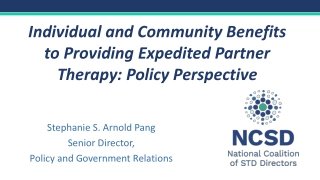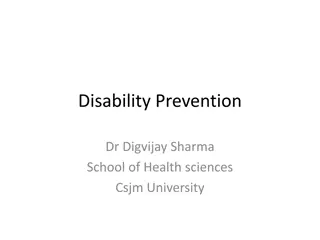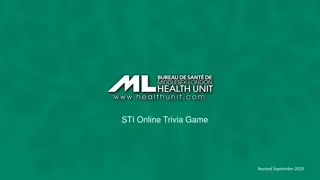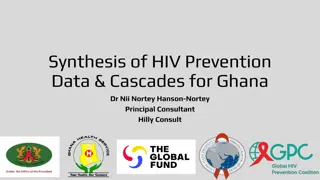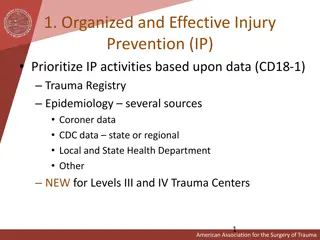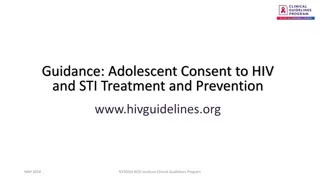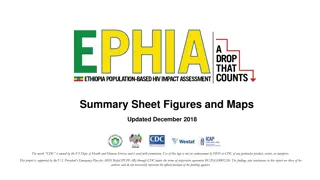From Data to Options: Advances in STI Prevention
Explore insights shared by Dr. Hyman M. Scott on trends in sexually transmitted infections, the impact of doxycycline prophylaxis, and potential effects of meningitis vaccination on STI rates. Gain understanding of rising STI rates in the US, chlamydia and gonorrhea cases, and recommendations for STI prevention strategies.
Download Presentation

Please find below an Image/Link to download the presentation.
The content on the website is provided AS IS for your information and personal use only. It may not be sold, licensed, or shared on other websites without obtaining consent from the author.If you encounter any issues during the download, it is possible that the publisher has removed the file from their server.
You are allowed to download the files provided on this website for personal or commercial use, subject to the condition that they are used lawfully. All files are the property of their respective owners.
The content on the website is provided AS IS for your information and personal use only. It may not be sold, licensed, or shared on other websites without obtaining consent from the author.
E N D
Presentation Transcript
From Data to Options: Advances in STI Prevention Hyman M. Scott, MD, MPH Assistant Clinical Professor University of California San Francisco
Financial Relationships With Ineligible Companies (Formerly Described as Commercial Interests by the ACCME) Within the Last 2 Years Dr Scott reported no relevant financial relationships with ineligible companies. (Updated February 27, 2024) Slide 2
Learning Objectives After attending this presentation, learners will be able to: Describe the trends in sexually transmitted infections overall and by populations in the US Describe the impact of doxycycline postexposure prophylaxis on sexually transmitted infection incidence in real-world settings Describe the potential impact of meningitis vaccination on gonorrhea incidence Slide 3
STI Epidemiology Slide 4
Rising STI Rates in the US https://www.cdc.gov/std/statistics/infographic.htm Slide 5 Slide 5
Chlamydia Rates of Reported Cases by Year, United States, 1984 2021 * Per 100,000 Slide 6
Gonorrhea Reported Cases by Reporting Source and Sex, United States, 2012 2021 NOTE: During 2012 to 2021, the proportion of all male cases with unknown reporting source was 13.6%, from a low of 11.9% in 2012 to a high of 14.4% in 2019. Slide 7
Doxycycline PEP for STI Prevention Slide 8
ARS Question 34 yo cisgender man currently on Daily oral PrEP since 2018 and history of multiple bacterial STIs in the last 4 years recently started Doxycycline PEP. He recently had negative 3-site GC/CT NAAT testing and RPR 2 months prior. A sexual partner texted him yesterday to report a diagnosis of gonorrhea (he is unsure of the site). He had oral and anal (receptive and insertive) with this partner 2 weeks ago. He has been taking DoxyPEP within 24hrs with all of his sexual partners except his husband. He has no allergies. In addition to 3-site NAAT testing, what would you recommend? Slide 9 Slide 9
Intervention: Open label doxycycline 200mg taken as PEP within 72 hours after condomless sexual contact Maximum of 200 mg every 24 hours Inclusion criteria: - Male sex at birth - With HIV or on PrEP - 1 STI in past 12 months - Condomless sex with 1 male partner in past 12 months STI Testing: Quarterly 3 site GC/CT testing + RPR, GC culture before treatment Sites: San Francisco & Seattle HIV & STI clinics Doxy PEP MSM & TGW with HIV (planned n = 390) No PEP Month 0 3 6 9 12 STI testing 2:1 randomization MSM & TGW on HIV PrEP (planned n = 390) Doxy PEP No PEP Month 0 3 6 9 12 STI testing Luetkemeyer, NEJM 2023;388:1296-1306. Slide 10
Primary Endpoint: STI incidence per quarter 31.9% (82/257) 30.5% (39/129) Risk reduction in STI incidence/quarter (95% CI) 66% PrEP (54% - 76%) 62% with HIV (40% - 76%) 11.8% (36/305) 65% 10.7% (61/570) Total (54% - 73%) all p< 0.0001 Luetkemeyer, NEJM 2023;388:1296-306. Slide 11
Individual quarterly STI incidence by study arm & cohort Gonorrhea Risk reduction in each STI per quarter (95% CI) Chlamydia PrEP 55% PWH 57% GC (35%-68%) p<0.0001 88% (75%-95%) p<0.0001 87% (41%-97%) p=0.0084 (29%-74%) p=0.001 74% (43%-88%) p=0.0007 77% (-71%, 96%) p=0.095 CT Syphilis Syphilis Similar efficacy against asymptomatic and symptomatic STIs Luetkemeyer, NEJM 2023;388:1296-1306. Slide 12
Tetracycline resistance (TCN-R) in incident GC with culture data TCN-R similar in incident GC at baseline and on doxy-PEP (1) (2) (2) (3) (4) Increased TCN-R in doxy- PEP vs. standard of care suggests doxy-PEP may be less protective against GC strains with existing TCN-R (17) (13) (16) Limited by low number of GC samples with MIC results (56/320) Slide 13 Luetkemeyer CROI 2023
S. Aureus colonization: 14% absolute decrease in doxy-PEP arm p = 0.15 S. aureus colonization is associated with subsequent clinical Staph infections, such as surgical infections and bacteremia.2 p < 0.01 14% point DoxyPEP use associated with 14% absolute decrease in S. aureus colonization. 2 Oestergard AIM 2016; Jacobsson Scand JID 2008; Septimus CID 2016; Bode NEJM 2010 Luetkemeyer CROI 2023 Slide 14
S. aureus: 8% increase in doxycycline resistance in doxy-PEP arm p = 0.15 Doxy-R low in both arms; imbalance at baseline. p < 0.01 8% absolute increase in resistance in doxy-PEP arm from baseline. p < 0.01 p = 0.16 8% point Slide 15 Luetkemeyer CROI 2023
New DoxyPEP data from CROI 2024 Slide 16
CROI 2024 Abstract 125 Sustained reduction in STIs during OLE
CROI 2024 Abstract 125 Sexual behavior during OLE As-randomized doxy-PEP N quarters = 1077 15 (4-30) 10 (4-25) AR OLE SOC doxy-PEP N quarters = 146 17 (5-30) 16.5 (5-31) SOC doxy-PEP N quarters = 388 17 (7-32) 12 (6-25) N quarters = 455 8 (4-15) Median doxy doses/quarter Sex partners/quarter Condomless insertive sex acts/quarter Condomless receptive sex acts/quarter % of condomless sex acts covered by doxy-PEP per quarter 5 (1-20) 4 (2-12) 8 (2-20) 8 (3-25) 8 (2-20) 5 (1-15) 10 (2-23.5) 10 (2-25) 82.4% 77.3% 81.3% Sexual partners: during OLE; more pronounced increase in SOC doxy-PEP Condomless sex acts: in both OLE groups Reported doxy-PEP coverage of condomless sex: High (> 75%) during OLE; comparable to doxy-PEP AR
CROI 2024 Abstract 1154 Impact of DoxyPEP on Gut Microbiome Minimal impact on gut microbiome Increased expression of tetracycline resistance genes in microbiome
ANRS DOXYVAC Study Design Multicenter, 2 x 2 factorial randomized, open-label, superiority, phase III trial (NCT04597424) Primary efficacy end-points: impact of DoxyPEP on time to a first episode of syphilis or chlamydia and impact of the 4CMenB vaccine on time to a first episode of N. gonorrhoeae infection. Sample size: based on vaccine effectiveness assuming no impact of Doxy on GC: 720 subjects needed for an HR: 0.70 (Estimated probability of a first GC episode over 18 months: 52%, power 85%, 18% lost to FU). Quarterly visits with PCR tests (Roche dual target Cobas ) for GC/CT/MG (3 sites) and serology for TP Doxycycline monohydrate purchased from Mylan and 4CMenB vaccine purchased from GSK CROI 2024 Abstract 124
Doxycycline PEP Time to First CT and Syphilis Infection CT Syphilis 92 subjects infected 39 subjects infected 68 in No PEP arm (incidence: 42.1/100 PY), 24 in Doxy PEP arm (incidence: 5.9/100 PY) 27 in No PEP arm (incidence: 14.5/100 PY), 12 in Doxy PEP arm (incidence: 2.9/100 PY) CROI 2024 Abstract 124
Doxycycline PEP Time to First GC GC 238 subjects infected Interim analyis: 84 subjects infected, aHR: 0.49 94 in No PEP arm (incidence: 68.4/100 PY) 144 in Doxy PEP arm (incidence: 45.5 /100 PY) CROI 2024 Abstract 124
Adherence to Doxy PEP Percent of Pts with quantifiable levels of doxycycline in plasma and urine Limit of quantification: 2.5 ng/mL and 50 ng/ml in plasma and urine, respectively Median (IQR) time to PEP intake: 15h (3-13) after sex Median (IQR) PEP use reported per participant at last sex act: >70% Median no. of pills/month (IQR): 6 pills (3-13) CROI 2024 Abstract 124
4CMenB Vaccine Time to First GC infection No interaction between Doxy PEP and 4CMenB vaccine (p=0.82) 225 subjects infected 122 in No Vaccine arm (incidence: 77.1/100 PY), 103 in 4CMenB vaccine arm (incidence: 58.3/100 PY) Interim analyis: 49 subjects infected, aHR: 0.49 (95%CI: 0.27 - 0.88) GC infections were considered from M3 visit (1 month after 2ndvaccine dose) CROI 2024 Abstract 124
4CMenB Vaccine Secondary Efficacy Outcomes 4CMenB vaccine (N=274) No vaccine (N=270) Adjusted hazard ratio (95% CI) Positive p-value Events Events (Incidence per 100 p-y) (Incidence per 100 p-y) First episode Gonorrhea (all sites) 103 (58.3) 122 (77.1) 0.78 (0.60-1.01) 0.06 Anal Gonorrhea Pharyngeal Gonorrhea Urinary Gonorrhea Symptomatic Gonorrhea Culture Positive Gonorrhea 61 (29.7) 58 (27.6) 13 (5.4) 12 (5.0) 26 (14.7) 64 (33.1) 74 (37.7) 10 (4.3) 14 (6.1) 25 (15.8) 0.90 (0.64-1.28) 0.75 (0.53-1.05) 1.29 (0.56-2.94) 0.82 (0.38-1.78) 0.95 (0.55-1.65) Adjusted IRR (95% CI) 0.84 (0.67-1.07) 1.04 (0.77-1.40) 0.84 (0.62-1.13) 1.45 (0.70-3.01) 0.77 (0.36-1.65) 1.00 (0.59-1.68) 0.57 0.09 0.55 0.62 0.86 Cumulative incidence Gonorrhea (all sites) 0.16 0.82 0.25 0.32 0.51 1.00 132 (52.6) 88 (35.1) 80 (31.9) 18 (7.2) 12 (4.8) 29 (11.6) 151 (62.4) 82 (33.9) 92 (38.0) 12 (5.0) 15 (6.2) 28 (11.6) Anal Gonorrhea Pharyngeal Gonorrhea Urinary Gonorrhea Symptomatic Gonorrhea Culture Positive Gonorrhea CROI 2024 Abstract 124
DoxyPEP Implementation @ Magnet Clinic (SFAF) CROI 2024 Abstract 126 DoxyPE P Offered Pre-DoxyPEP Period Post-DoxyPEP Period Non-DoxyPEP Users: 1,872 (61%) Non-DoxyPEP Users All PrEP Users DoxyPEP Users: 1,209 (39%) DoxyPEP Users Q2 Q5 Q4 Q1 Q3 6/2022 9/2022 3/2023 6/2023 9/2023 12/202 2 Slide 26
STI Incidence among DoxyPEP Users (Pre-Post Analysis) IRR 95% CI 0.24 - 0.74 0.23 - 0.46 0.09 - 0.54 0.69 - 1.15 p-value 0.003 <0.001 0.001 0.383 Any STI Chlamydia Syphilis Gonorrhea 0.42 0.33 0.22 0.89 CROI 2024 Abstract 126 Any STI: Chlamydia, Syphilis, or Gonorrhea infection Slide 27
Interrupted Time Series: STI Incidence Pre- Post- DoxyPEP A CROI 2024 Abstract 126 Specific STI Incidence Per Quarter ITS: Any STI: p=0.032; Chlamydia: p=0.021; Gonorrhea: p=0.003; Syphilis: p=0.360 Slide 28
CROI 2024 Abstract 127 Background: STI Trends in San Francisco MSM and TGW, 2014-2023 1800 350 Chlamydia Gonorrhea Early Syphilis COVID doxy-PEP 1600 300 1400 # reported GC or CT cases 250 # reported ES cases 1200 200 1000 800 150 pre-period post-period 600 100 400 50 200 0 0 2014-Q1 2015-Q1 2016-Q1 2017-Q1 2018-Q1 2019-Q1 2020-Q1 2021-Q1 2022-Q1 2023-Q1
Chlamydia Results: Monthly SF cases among MSM and TGW 6.6%/month decrease in chlamydia cases in post- period (p<0.0001) 350 300 Reported chlamydia cases 250 Predicted trend Pre-period trend 200 50% decrease in chlamydia cases in November 2023 (95% CI: 38%-59%) 150 Post-period trend 100 50 0 Jul-21 Nov-21 Mar-22 Jul-22 Nov-22 Mar-23 Jul-23 Nov-23 CROI 2024 Abstract 127
Early Syphilis Results: Monthly SF cases among MSM and TGW 2.7%/month decrease in early syphilis cases in post-period (p<0.0001) 120 Pre-period trend 100 Predicted trend Reported early syphilis cases 80 51% decrease in early syphilis cases in November 2023 (95% CI: 43%-58%) 60 Post-period trend 40 20 0 Jul-21 Nov-21 Mar-22 Jul-22 Nov-22 Mar-23 Jul-23 Nov-23 CROI 2024 Abstract 127
Gonorrhea Results: Monthly SF cases among MSM and TGW 450 Pre-period trend 1.8%/month increase in gonorrhea cases in post-period (p<0.0001) 400 Post-period trend 350 Reported gonorrhea cases 300 250 Predicted trend 1.8%/month decrease in gonorrhea cases in pre-period (p<0.0001) 200 150 100 50 0 Jul-21 Nov-21 Mar-22 Jul-22 Nov-22 Mar-23 Jul-23 Nov-23 CROI 2024 Abstract 127
Analysis of Doxycycline in hair levels among cisgender women in Kenya Doxycycline levels were low (29%) Use was associated with age > 24yrs; & not having a primary partner CROI 2024 Abstract 1148
Who Should be Offered doxy-PEP? Current guidelines do not agree More restrictive use Broader use Broadest ASHM (Sept 2023): Use doxy-PEP primarily for prevention of syphilis in GBMSM; Use for defined period of time San Francisco DPH (Oct 2022): Tiered: Recommend to study population; Offer to broader group(Trans women, trans men and MSM with multiple cis male partners but without STI diagnosis in prior 12 months) Public Health England/BASHH (2017): Not endorsed; re-evaluating IAS-USA (Dec 2022): Case-by case US CDC Draft (Oct 2023): A1 recommendation for MSM and transwomen with at least 1 STI in past year; Insufficient evidence for other groups Seattle King County (June 2023): Inform (not recommend); prioritize hx of syphilis or multiple STIs California DPH (April 2023): Tiered: Offer to all non pregnant individuals at increased risk for bacterial STIs and those requesting doxy-PEP German STI Society (Aug 2023): Case-by-case; Reserved for selected individuals Slide courtesy of Stephanie Cohen
Preliminary CDC doxy Preliminary CDC doxy- -PEP guidelines Posted for public comment 10/1/23 Posted for public comment 10/1/23 PEP guidelines Although not directly assessed in the trials included in these guidelines, doxycycline PEP could be considered for MSM and TGW who have not been diagnosed with an STI in the prior year but will be participating in sexual activities that are known to increase likelihood of exposure to STIs, e.g., during weekend events, cruises, and festival Although the pharmacokinetics of doxycycline and experience in treating bacterial STIs suggest that STI PEP with doxycycline should be effective in other populations, data to support doxycycline as PEP in other populations (i.e., cisgender women, cisgender heterosexual men, transgender men, other queer and nonbinary individuals) are limited https://www.regulations.gov/document/CDC-2023-0080-0002 Slide courtesy of Stephanie Cohen
Gonorrhea Vaccine? Slide 36
Why Outer Membrane Vesicle (OMV) vaccines? Molecular and Epidemiologic data support that outer membrane vesicle vaccines (OMV) may protect against gonorrhea Vaccination campaigns aimed at N. meningitides have been linked with declines in gonococcal disease Outer membrane vesicle of N. meningitides elicits cross-reactive antibodies to N. gonorrhoeae Mass vaccination of college students and staff in Oregon in response to a meningitis outbreak 15,760 OMV vaccine recipients and 15,212 non-OMV vaccine recipients. Vaccine effectiveness of 47% (95% CI, 13%-68%) among 18-29 year olds Vaccine effectiveness of 59% (95% CI: 20%-79%) among 18-19 year olds Petousis-Harris Lancet 2017; Semchenko CID 2019 Robison JAMA Netwk Open 2023 Slide 38
Study Objectives Primary Objective To demonstrate efficacy of Bexsero in prevention of urogenital and/or anorectal gonococcal infection. Secondary Objectives 1.To estimate efficacy of Bexsero in prevention of overall gonococcal infection and by anatomical site (urogenital, anorectal or pharyngeal). 2.To assess safety of Bexsero. Slide 39
Meningococcal Vaccine Against Gonococcal Infection (MAGI) Study Who will enroll? 18-50 years old people who are in good health and at increased risk for gonorrhea infection. Cannot have received Men B vaccine in the past; No GC or CT diagnosis in the past 14 days; or antibiotics to GC in past 14 days Slide 40
MAGI Study Schedule Slide 41
Summary Continued increase in STIs in the US largest increase among syphilis. DoxyPEP efficacy sustained in extension of DoxyPEP trial (including for gonorrhea prevention). Real-world implementation shows high efficacy for syphilis and Chalmydia, but not gonorrhea. Early evidence of population level impact of DoxyPEP in San Francisco after only 1 year. Low adherence may explain lack of DoxyPEP efficacy in cisgender women May need additional tools for gonorrhea prevention Slide 42




